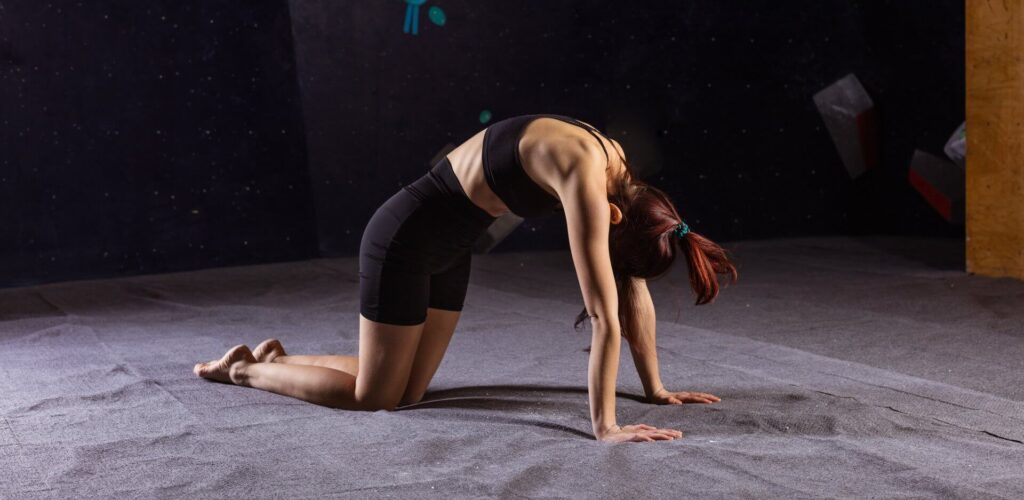“Marjaryasana teaches us to honor the natural curves of our body, finding strength in flexibility and embracing our own flow.”
Cat Pose – Marjaryasana, is a foundational yoga posture that exemplifies grace and simplicity. This beginner-friendly asana involves flowing through a gentle arching and rounding of the spine while on all fours. Marjaryasana is celebrated for its ability to enhance spinal flexibility, improve posture, and promote relaxation.
Marjaryasana Meaning
The name “Marjaryasana” is derived from the Sanskrit words “Marjari,” meaning “cat,” and “Asana,” meaning “pose.” The pose symbolizes the fluid, feline-like movements of a cat arching and rounding its back.
Benefits Cat Pose – Marjaryasana
Cat Pose (Marjaryasana) offers several physical and mental benefits for beginners:
- Spinal Flexibility: It enhances spinal flexibility by gently arching and rounding the back.
- Core Activation: The pose engages and strengthens the core muscles.
- Stress Reduction: It promotes relaxation and stress reduction through mindful movement.
- Improved Posture: Regular practice can help improve posture and alignment.
- Enhanced Coordination: Marjaryasana enhances coordination between breath and movement.
Step-by-Step Instructions Cat Pose – Marjaryasana

- Starting Position: Begin on your hands and knees in a tabletop position, aligning your wrists under your shoulders and knees under your hips.
- Inhale: Inhale deeply, lifting your tailbone and allowing your belly to drop toward the mat.
- Arch Your Back: As you inhale, gently arch your back, lifting your head and chest toward the ceiling. This is the “cow” part of the pose.
- Exhale: Exhale slowly, rounding your spine upward like a cat. Drop your head and tuck your chin toward your chest.
- Repeat Flow: Continue to flow between these two positions, syncing your breath with your movement. Inhale for the cow pose and exhale for the cat pose.
- Repeat: Repeat the flow for several breath cycles, moving at your own pace.
Cat Pose Variations and Modifications Marjaryasana
If you have wrist discomfort, you can perform Cat Pose on your fists instead of your palms. To intensify the stretch, you can perform the pose while on your forearms instead of your hands.
Tips for a Deeper Practice Cat Pose – Marjaryasana
Pay attention to the alignment of your wrists under your shoulders and knees under your hips. Focus on the fluidity and mindfulness of the movement, syncing your breath with each transition.
Preparation Poses Cat Pose – Marjaryasana
- Child’s Pose (Balasana): Begin your practice with Child’s Pose to warm up and center yourself.
Alternative Poses for Cat Pose – Marjaryasana
- Downward-Facing Dog (Adho Mukha Svanasana): After practicing Cat Pose, transition into Downward-Facing Dog to stretch and elongate the spine.
Final Thoughts
Cat Pose (Marjaryasana) is a gentle and beginner-friendly yoga asana that enhances spinal flexibility and relaxation. Its fluid movements mimic the grace of a cat, inviting a sense of mindfulness and ease into your practice. Incorporate Marjaryasana into your yoga routine to experience its benefits for the spine, core, and overall well-being. As you flow through the arching and rounding of the back, embrace the simplicity and beauty of this foundational pose.
Cat Pose serves as a reminder of the natural elegance and grace that yoga brings to our bodies and minds.
FAQ Cat Pose
Is Cat Pose a Beginners Pose?
Yes, Cat Pose is a beginner’s pose.
What is the Origin of Marjaryasana?
Marjaryasana, also known as Cat Pose, originates from Hatha Yoga.
Which Poses should I consider following up on Cat Pose and why?
Consider following up on the following poses after Cat Pose:
– Cow Pose: It complements Cat Pose by gently stretching and opening the chest, while also increasing flexibility in the spine.
– Child’s Pose: It provides a gentle stretch to the lower back and hips, promoting relaxation and release of tension.
– Downward Facing Dog Pose: It helps to lengthen and strengthen the entire body, particularly the arms, shoulders, and legs. It also stretches the hamstrings and calves.
– Sphinx Pose: It helps to strengthen the spine and stretch the chest, abdomen, and shoulders.
– Thread the Needle Pose: It provides a deep stretch to the upper back, shoulders, and neck, releasing tension and promoting mobility.
Remember to listen to your body and modify the poses as needed. It’s always a good idea to consult with a qualified yoga instructor before starting a new yoga practice.


